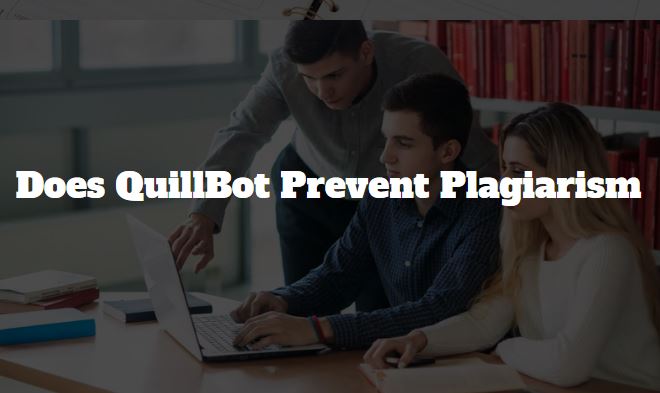Does QuillBot Prevent Plagiarism
Plagiarism, as any writer will tell you, is a serious issue. Whether you’re writing for school, pleasure, or profit, it’s imperative that your writing is 100% your work.
This is because the internet provides an excellent platform to showcase your writing and creativity to the world. But imagine the embarrassment when someone points out a section or an entire article has been stolen and published under your name.
You don’t want this to happen to you, so what can you do to prevent plagiarism? Do online plagiarism checker tools help, or does QuillBot prevent plagiarism? Let’s find out together.
Does Quillbot Prevent Plagiarism
QuillBot is a free online paraphrasing tool but can also be used to prevent plagiarism as it has a plagiarism-checker option. It helps students rewrite articles and is also helpful for many other purposes, but it’s most commonly used to rewrite content for blogs and websites.
New Service Alert!!!
We are now taking exams and courses
This tool differs from other paraphrasing tools because it has an AI-powered system. Instead of giving you a list of synonyms, as other tools do, QuillBot reads your article word for word and then produces an entirely new version of the text using its built-in dictionary.
Also see: Can Turnitin detect quillbot?
Further, it can detect plagiarism, check for grammar mistakes, and improve your writing style. The tool also has a browser extension installable on Chrome, Safari, Opera, Firefox, and Edge
The tool prevents plagiarism by automatically checking your papers against millions of other documents to ensure they are original. Its algorithm checks all paragraphs against each other to ensure someone didn’t copy and paste multiple sections from different sources into one paper.
If you use the exact words in different parts of your paper (for example, “this” or “that”), QuillBot will also flag those paragraphs as duplicates and ask you to rewrite them, so they are unique.
Is Using Quillbot Plagiarism
Using QuillBot is not necessarily considered plagiarism, especially if used as per its intentions. However, there is a lot of controversy surrounding using QuillBot as a content creation tool that allows you to create content quickly and easily. Many people claim that using this tool is plagiarism, while others claim that it is not.
The first thing we need to do is understand what plagiarism is. According to the Merriam-Webster dictionary, plagiarism is “the unauthorized use or close imitation of the language and thoughts of another author and the representation of them as one’s original work.”
New Service Alert!!!
We are now taking exams and courses
This means if you use the tool and your work contains similarities with another person’s work without giving credit, it could be considered plagiarism. On the other hand, using a tool like QuillBot does not constitute plagiarism because it does not involve copying someone else’s work directly from their website or their sentences word for word.
Instead, it involves creating content based on what others had written about a topic. With the tool, you add more material and details or change things around so that it does not appear exactly as is from where you get the information.
Thus, its use may or may not be considered plagiarism, depending on how you use it.
Does Paraphrasing Tool Avoid Plagiarism
Many websites provide paraphrasing tools and claim to avoid plagiarism. However, this is not a guarantee that these tools prevent plagiarism, and you should use them cautiously.
There are two main reasons why you should not use them. The first is that they don’t always work as expected. You can try using some of these tools and see if they work for you or not. This means you may end up with a high level of plagiarism if you follow their word of the tools being plagiarism-free.
Further, even if the paraphrasing tools work, they may not be able to detect all instances of plagiarism in your content. In fact, many such tools can only catch similar words or phrases and cannot detect more complex forms of plagiarism like sentence and paragraph structure.
Additionally, paraphrasing tools do not always produce unique content. If two individuals type an entire paragraph into the software and have it reworded, they may technically end up with a similar or almost similar output. This means the second individual may be flagged off as a plagiarist, although it is not intentional.
New Service Alert!!!
We are now taking exams and courses
The best way is always to add your content in the paraphrased content to avoid such instances.
How to Avoid Plagiarism in College Essays
While there are various types of plagiarism, the most common form is when you take the words or ideas of someone else and present them as your own. This can be accidental or deliberate, and it is usually unintentional.
However, there are ways to avoid plagiarism in your writing.
- Conduct thorough research. When writing an essay, it is necessary to do some research so that you will be able to come up with new ideas or develop fresh perspectives on a particular topic. You should also find out more about how others have dealt with similar issues and what they have said about them so that you can avoid repeating what they have already said. However, when doing so, ensure you don’t copy the whole thing word for word from other sources since this will get you into trouble with your professor and vice versa.
- Always cite sources properly so that it is clear where the information came from.
- This means that instead of copying someone else’s words or ideas, you’ll put them into your own words, so they don’t sound exactly like someone else’s writing. You can do this with the help of a paraphrasing tool, but be careful to proofread and don’t take the tool’s output as the final content.

